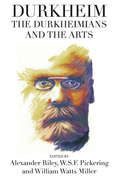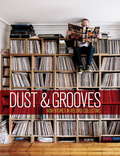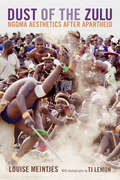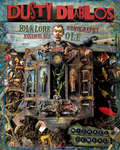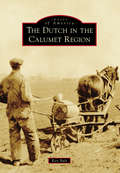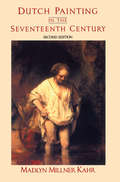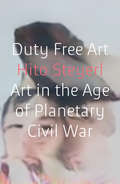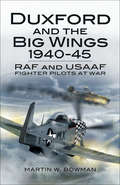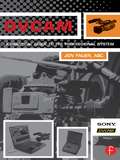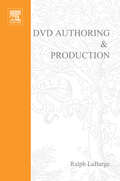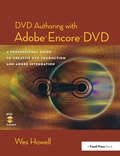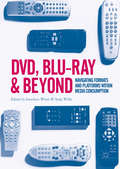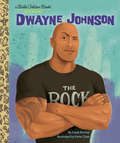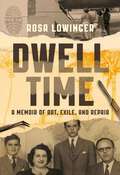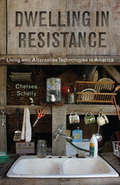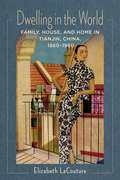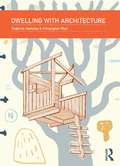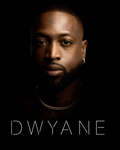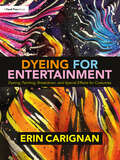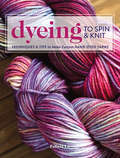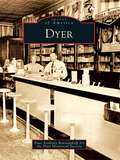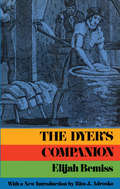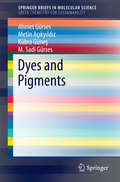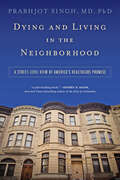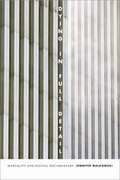- Table View
- List View
Durkheim, the Durkheimians, and the Arts
by W.S.F. Pickering Alexander Tristan Riley William Watts MillerUsing a broad definition of the Durkheimian tradition, this book offers the first systematic attempt to explore the Durkheimians' engagement with art. It focuses on both Durkheim and his contemporaries as well as later thinkers influenced by his work. The first five chapters consider Durkheim's own exploration of art; the remaining six look at other Durkheimian thinkers, including Marcel Mauss, Henri Hubert, Maurice Halbwachs, Claude Lévi-Strauss, Michel Leiris, and Georges Bataille. The contributors-scholars from a range of theoretical orientations and disciplinary perspectives-are known for having already produced significant contributions to the study of Durkheim. This book will interest not only scholars of Durkheim and his tradition but also those concerned with aesthetic theory and the sociology and history of art.
Dust & Grooves
by Eilon Paz RzaDust & Grooves: Adventures in Record Collecting is an inside look into the world of vinyl record collectors in the most intimate of environments--their record rooms. Compelling photographic essays from photographer Eilon Paz are paired with in-depth and insightful interviews to illustrate what motivates these collectors to keep digging for more records. The reader gets an up close and personal look at a variety of well-known vinyl champions, including Gilles Peterson and King Britt, as well as a glimpse into the collections of known and unknown DJs, producers, record dealers, and everyday enthusiasts. Driven by his love for vinyl records, Paz takes us on a five-year journey unearthing the very soul of the vinyl community.From the Hardcover edition.& Grooves is a celebration of passion and discovery and a tribute to the spirit of a thriving movement.
Dust of the Zulu: Ngoma Aesthetics after Apartheid
by Louise Meintjes Tj LemonIn Dust of the Zulu Louise Meintjes traces the political and aesthetic significance of ngoma, a competitive form of dance and music that emerged out of the legacies of colonialism and apartheid in South Africa. Contextualizing ngoma within South Africa's history of violence, migrant labor, the HIV epidemic, and the world music market, Meintjes follows a community ngoma team and its professional subgroup during the twenty years after apartheid's end. She intricately ties aesthetics to politics, embodiment to the voice, and masculine anger to eloquence and virtuosity, relating the visceral experience of ngoma performances as they embody the expanse of South African history. Meintjes also shows how ngoma helps build community, cultivate responsible manhood, and provide its participants with a means to reconcile South Africa's past with its postapartheid future. Dust of the Zulu includes over one hundred photographs of ngoma performances, the majority taken by award-winning photojournalist TJ Lemon.
Dusty Diablos: Folklore, Iconography, Assemblage, Ole!
by Michael Demeng Tonia DavenportAssemblage ole! Bring your artistic yearnings and sense of adventure along on a journey to the land of Dusty Diablos. Inspiration seeps from every page, and inside here you'll find: a tasty mix of ancient folklore (from the ancient metropolis of Teotihuacán to the miracle witnessed by Juan Diego); colorful pop culture (who knew that Western-Horror was its own film genre or that there's an entire island overrun with misfit dolls?) and informative art-making how-tos (like the Tricky Burnt Paper Routine and crafting your own Nicho). Join author Michael deMeng on an artist's pilgrimage south of the border and experience a culture as rich as it is beautiful and as genuine and down-to-earth as it is humorous and fascinating. While being mesmerized by all the amazing assemblage pieces, you also learn such nifty things as: Mixing up Michael's favorite paint washes to achieve "rusty" results in your own work Crafting your own slithering serpent Creating miniature story boxes Aging bottle caps with beer and so much more! Indulge your senses and come along for a trip through crowded marketplaces, a thrilling taxicab ride and the intoxicating festivities of Dia de los Muertos and discover the allure of Dusty Diablos. You might not want to leave.
Dutch in the Calumet Region, The
by Ken BultThe first Dutch immigration to the Calumet Region took place in the second half of the 19th century. The area settled by the Dutch spans roughly from what today is part of Chicago's Southside to the western border of Griffith, Indiana, and includes the communities of Roseland, South Holland, Lansing, Munster, and Highland. Once in the region, the Dutch carved communities out of the wilderness by clearing and draining the land and raising large families; descendants of these immigrants still populate the region. Even before the towns existed and on into the 20th century, the Dutch were a community that transcended the borders they established. Evidence of the early settlers is found all around the Calumet Region. It is in the churches they built, the businesses they started, and the loved ones they buried.
Dutch Painting In The Seventeenth Century
by Madlyn Millner KahrThis new edition of an established survey of the Golden Age of Dutch painting has been revised, corrected, and updated in the text, notes, and bibliography as a result of new scholarship. The author has written a new preface to this edition. Rembrandt, Vermeer, Hals, Ruisdael, Cuyp, de Witte, van Goyen, van de Velde, Hobbema, Fabritius, de Hooch, and Saenrendam are some of the painters included and discussed.
Duty Free Art: Art in the Age of Planetary Civil War
by Hito SteyerlWhat is the function of art in the era of digital globalization?How can one think of art institutions in an age defined by planetary civil war, growing inequality, and proprietary digital technology? The boundaries of such institutions have grown fuzzy. They extend from a region where the audience is pumped for tweets to a future of “neurocurating,” in which paintings surveil their audience via facial recognition and eye tracking to assess their popularity and to scan for suspicious activity. In Duty Free Art, filmmaker and writer Hito Steyerl wonders how we can appreciate, or even make art, in the present age. What can we do when arms manufacturers sponsor museums, and some of the world’s most valuable artworks are used as currency in a global futures market detached from productive work? Can we distinguish between information, fake news, and the digital white noise that bombards our everyday lives? Exploring subjects as diverse as video games, WikiLeaks files, the proliferation of freeports, and political actions, she exposes the paradoxes within globalization, political economies, visual culture, and the status of art production.
Duxford and the Big Wings, 1940–45: RAF and USAAF Fighter Pilots at War
by Martin W. BowmanA pulsating account of the young RAF and American fighter boys who flew Spitfires, Hurricanes, Thunderbolts and Mustangs during 1940-45. It is unique in that the story is told using first person accounts from RAF, German and American Eagles who fought in the skies over England in the Battle of Britain in the summer of 1940 and the great air offensives over occupied-Europe from 1942 onwards. The first five and a half chapters cover the Battle of Britain period when the RAF squadrons fought dog fights with the Luftwaffe and then fought them in gathering strength using the Big Wings to meet the bomber fleets attacking London. The second part of the book covers the Eagle squadron period, which was expanded with Americas entry into the war. The action moves to the USAAF Big Wings of Thunderbolts and Mustang fighters that flew escort missions and dueled with the Luftwaffe over the continent during the massive bomber raids on German targets in France, the Low Countries and the Reich itself. A whole host of incredible first hand accounts by British, Polish, Czech, German and American fighter pilots permeate the action and describe the aerial battles as only they can. This unique book also includes many accounts and photos that have not previously been seen before while the rich mix of combat accounts from all sides are brought together for the first time in one volume.
DVCAM: A Practical Guide to the Professional System
by Jon Fauer, ASCDVCAM: A Practical Guide to the Professional System, is a nuts and bolts guide for anyone who wants to learn more about Sony DVCAM, to determine what equipment to use, how various models compare, and how to use each of them. A user-friendly overview of the DVCAM format and its equipment, the text covers camcorders, cameras, tape, VTRs, editors, and accessories. The focus is on quick guides (Jump Start chapters) that show how to use the various Sony DVCAM camcorders: DSR-PD100A, DSR-PD150, DSR-250, DSR-300A, and DSR-500WS. Professionals, film students, independent feature filmmakers, schools, government agencies and military services, and news crews will benefit from its hands-on approach. This comprehensive, hands-on book is an overview of the DVCAM format and its equipment. DVCAM is the professional video standard developed by Sony, based on the consumer DV video format. In the five years since DVCAM was introduced, over 200,000 cameras and VTRs have been sold, making it the best-selling professional format of all time.
DVD Authoring and Production: An Authoritative Guide to DVD-Video, DVD-ROM, & WebDVD
by Ralph LaBargeDVD Authoring and Production is an authoritative and comprehensive guide to publishing content in the DVD-Video, DVD-ROM, and WebDVD formats. Readers learn everything they need to create, produce, and master DVDs - including a firsthand look at professional production techniques employed in the author's StarGaze DVD. Professionals and aspiring DVD artists alike learn the latest tools and techniques as well as how to succeed in the business realm of the DVD world, including optimal methods of marketing, distributing, and selling.
DVD Authoring with Adobe Encore DVD: A Professional Guide to Creative DVD Production and Adobe Integration
by Wes HowellExpand your creative ability by mastering the software tools. "DVD Authoring with Adobe Encore DVD" covers the toolset in a manner that demonstrates real-world application. The downloadable resources with source material walks you through the process. You will learn how to avoid common pitfalls and learn about the entire DVD authoring workflow.
DVD, Blu-ray and Beyond: Navigating Formats and Platforms within Media Consumption
by Andy Willis Jonathan WrootThis book demonstrates, in contrast to statistics that show declining consumption of physical formats, that there has not been a mass shift towards purely digital media. Physical releases such as special editions, DVD box-sets and Blu-Rays are frequently promoted and sought out by consumers. And that past formats such as VHS, Laserdisc and HD-DVD make for sought-after collectible items. These trends are also found within particular genres and niche categories, such as documentary, education and independent film distribution. Through its case studies, this collection makes a distinctive and significant intervention in highlighting the ways in which the film industry has responded to rapidly changing markets. This volume, global in scope, will prove useful to those studying the distribution and exhibition of films, and the economics of the film industry around the world.
Dwayne Johnson: A Little Golden Book Biography (Little Golden Book)
by Frank BerriosHelp your little one dream big with a Little Golden Book biography about superstar Dwayne "The Rock" Johnson! It's the perfect introduction to nonfiction for preschoolers.This Little Golden Book about Dwayne "The Rock" Johnson—wrestling star, movie star, TV star, and all-around nice guy—is an inspiring read-aloud. Young children will learn that even superstars have setbacks: when Dwayne's dream of playing in the NFL didn't come true, he had to find a different path to happiness and success.Look for more Little Golden Book biographies: • Betty White • Carol Burnett • Lucille Ball • Harry Belafonte • Julie Andrews
Dwell Time: A Memoir of Art, Exile, and Repair
by Rosa LowingerWhat Kirkus describes as a "masterful revelation about life and art imitating each other in maintenance and repair" in a starred review, Dwell Time is an illuminating debut memoir by one of the few prominent Latinas in the field of art and architectural conservation; a moving portrait of a Cuban Jewish family&’s intergenerational trauma; and a story about repair and healing that will forever change how you see the objects and places we cherish and how we manage damage and loss.Dwell Time is a term that measures the amount of time something takes to happen – immigrants waiting at a border, human eyes on a website, the minutes people wait in an airport, and, in art conservation, the time it takes for a chemical to react with a material.Renowned art conservator Rosa Lowinger spent a difficult childhood in Miami among people whose losses in the Cuban revolution, and earlier by the decimation of family in the Holocaust, clouded all family life.After moving away to escape the &“cloying exile&’s nostalgia,&” Lowinger discovered the unique field of art conservation, which led her to work in Tel Aviv, Philadelphia, Rome, Los Angeles, Honolulu, Charleston, Marfa, South Dakota, and Port-Au-Prince. Eventually returning to Havana for work, Lowinger suddenly finds herself embarking on a remarkable journey of family repair that begins, as it does in conservation, with an understanding of the origins of damage.Inspired by and structured similarly to Primo Levi&’s The Periodic Table, this first memoir by a working art conservator is organized by chapters based on the materials Lowinger handles in her thriving private practice – Marble, Limestone, Bronze, Ceramics, Concrete, Silver, Wood, Mosaic, Paint, Aluminum, Terrazzo, Steel, Glass and Plastics. Lowinger offers insider accounts of conservation that form the backbone of her immigrant family&’s story of healing that beautifully juxtaposes repair of the material with repair of the personal. Through Lowinger&’s relentless clear-eyed efforts to be the best practitioner possible while squarely facing her fraught personal and work relationships, she comes to terms with her identity as Cuban and Jewish, American and Latinx.Dwell Time is an immigrant&’s story seen through an entirely new lens, that which connects the material to the personal and helps us see what is possible when one opens one&’s heart to another person&’s wounds.From the book: &“How, I wondered, was it possible that no one in my family had ever told me that Havana, the place where we were from, was so closely aligned to my work? More importantly, how had I managed to reencounter this ornately decorated, sagging city at the precise moment when I was beginning to see a link between restoration of the material world and personal healing?&”
Dwelling in Resistance: Living with Alternative Technologies in America
by Chelsea SchellyMost Americans take for granted much of what is materially involved in the daily rituals of dwelling. In Dwelling in Resistance, Chelsea Schelly examines four alternative U.S. communities—“The Farm,” “Twin Oaks,” “Dancing Rabbit,” and “Earthships”—where electricity, water, heat, waste, food, and transportation practices differ markedly from those of the vast majority of Americans. Schelly portrays a wide range of residential living alternatives utilizing renewable, small-scale, de-centralized technologies. These technologies considerably change how individuals and communities interact with the material world, their natural environment, and one another. Using in depth interviews and compelling ethnographic observations, the book offers an insightful look at different communities’ practices and principles and their successful endeavors in sustainability and self-sufficiency.
Dwelling in the World: Family, House, and Home in Tianjin, China, 1860–1960 (Studies of the Weatherhead East Asian Institute, Columbia University)
by Elizabeth LaCoutureBy the early twentieth century, Chinese residents of the northern treaty-port city of Tianjin were dwelling in the world. Divided by nine foreign concessions, Tianjin was one of the world’s most colonized and cosmopolitan cities. Residents could circle the globe in an afternoon, strolling from a Chinese courtyard house through a Japanese garden past a French Beaux-Arts bank to dine at a German café and fall asleep in a British garden city-style semi-attached brick house.Dwelling in the World considers family, house, and home in Tianjin to explore how tempos and structures of everyday life changed with the fall of the Qing Empire and the rise of a colonized city. Elizabeth LaCouture argues that the intimate ideas and practices of the modern home were more important in shaping the gender and status identities of Tianjin’s urban elites than the new public ideology of the nation. Placing the Chinese home in a global context, she challenges Euro-American historical notions that the private sphere emerged from industrialization. She argues that concepts of individual property rights that emerged during the Republican era became foundational to state-society relations in early Communist housing reforms and in today’s middle-class real estate boom.Drawing on diverse sources from municipal archives, women’s magazines, and architectural field work to social surveys and colonial records, Dwelling in the World recasts Chinese social and cultural history, offering new perspectives on gender and class, colonialism and empire, visual and material culture, and technology and everyday life.
Dwelling with Architecture
by Roderick Kemsley Christopher PlattThe dwelling is the most fundamental building type, nowhere more so than in the open landscape. This book can be read in a number of ways. It is first a book about houses and particularly the theme ‘dwelling and the land’. It examines the poetic and prosaic issues inherent in claiming a piece of the landscape to live on. It could also be seen as a kind of road map, full of both warnings and encouragements for all those involved with, or just interested in, the making of houses. That the domestic realm and the landscape can be vehicles for significant architectural insights is hardly an original observation. However this book seeks to bring the two topics together in a unique way. In exploring a building type that lies on the cusp of what is commonly understood as ‘building’ and ‘architecture’, it asks fundamental questions about what the very nature of architecture is. Who indeed is the architect and what is their role in the process of creating meaningful buildings?
Dwyane: Get To Know Dwyane Wade Sr. And His Favorite Sports
by Dwyane WadeThe long-awaited photographic memoir from basketball superstar Dwyane Wade, beautifully designed with hundreds of photos from Wade’s life on and off the court.For 16 years, Dwyane Wade has dazzled basketball fans with his on-court artistry and has built his personal brand into one of the most powerful ones in sports. In this beautiful full-color memoir, featuring more than 200 photos from Bob Metelus, who has been documenting Wade’s career for more than a decade, Wade takes readers inside his fascinating life and career.Dwyane moves from Wade’s challenging upbringing on the South Side of Chicago through his college career at Marquette, where he went from unheralded recruit to one of college basketball’s greatest stars, to his extraordinary years with the Miami Heat, with whom he won three NBA championships and was named an All-Star 13 times. Off the court, too, his star has transcended basketball. In Dwyane he takes readers inside his relationship with Gabrielle Union; his dedication to his children and experiences as a father; and his varied interests outside of basketball, from fashion to winemaking.Dwyane is a deep dive into the mind and heart of one of the most compelling basketball players of all time.
Dyeing for Entertainment: Dyeing, Painting, Breakdown, and Special Effects for Costumes
by Erin CarignanDyeing for Entertainment encompasses a wide range of methods of theatrical painting and dyeing to create beautiful artistic products for theatre, film, TV, opera, and themed entertainment. Featuring examples from renowned international artisans in the field, this book provides a wealth of information on creating and changing colors, prints, and surface textures of fabric using traditional and nontraditional costume, scenic, fine-art, and metal-smithing techniques. It also includes new, safer materials and methods to minimize exposure to toxic materials and fumes. With more than 250 full-color images, this technical manual is designed to guide and inspire new artists in the collaborative art of painting, dyeing, ageing, and slinging blood and bling on costumes that is an essential part of creating characters for the entertainment industry. Written for undergraduate and graduate students of costume design and technology, professional dyers and breakdown artists, and cosplayers, this book can be used as a reference and springboard to create your own magical processes, custom fabrics, and unforgettable costumes. To access the online materials, including printable swatch sheets, a collection of relevant safety data sheets, and a source guide with links, visit www.routledge.com/9780815352327.
Dyeing to Spin & Knit: Techniques & Tips to Make Custom Hand-Dyed Yarns
by Felicia LoInspire and unleash a passion for hand-crafted color! "Unapologetic" is how Felicia Lo always describes her obsession with color and craft. In Dyeing to Spin and Knit, Felicia, founder and creative director of SweetGeorgia Yarns and highly sought after teacher and lecturer, provides clear and accessible guidance for creating gorgeous hand-dyed yarns and spinning fibers and an understanding of how dyeing affects knitted yarn and handspun yarn. Fiber artists will learn the fundamentals of how color works, how to combine and coordinate colors, and how to control the results when dyeing wool and silk yarns and fibers. Spinners will learn how to subdue intense and bright colorways or prevent muddiness in handspun. Knitters will gain the knowledge to avoid or maximize the effects of pooling. And finally, this book will include 10 patterns that use hand-dyed and handspun yarns and fibers to their most exciting advantage in knitting projects. Complete with detailed photographs from Felicia's own dyeing studio, Dyeing to Spin and Knit offers a master class in preparing hand-dyed yarns and fibers. Ignite your love of color--unapologetically!
Dyer (Images of America)
by Paul Anthony Benninghoff Dyer Historical SocietyWhat had once been an ancient shoreline of Lake Michigan, mired with swamp and sand dunes, is today the town of Dyer. Its history consists of the old Sauk Trail-turned-highway, strong-willed and hardworking visionaries such as Aaron Hart who drained the swamps and created farmlands, entrepreneurs who developed the early businesses and established Dyer as a town in 1910, and events such as the arrival of the locomotive and automobile that altered the lives of its citizens and shaped Dyer into the populated and bustling town it is today. From a sleepy farming community to a distant suburb of Chicago, the town of Dyer has a history both rich in its own right and very much tied to American history. One will see how a small American town unique to its geological location is impressed onto the land and how influences by events unfolding beyond its borders can help create, and sometimes jeopardize, its identity.
The Dyer's Companion
by Elijah BemissIn 1806, when Bemiss's Dyer's Companion first appeared, the American dyeing industry was beset with problems; Europe was trying to maintain control of the market, and American dyers were often undertrained with recipes selling from master to apprentice "for twenty and thirty dollars each." To remedy this situation, Elijah Bemiss wrote his book. Today Bemiss's work is still important for seeing the exact methods of natural dyeing and understanding the life of the dyer in the early nineteenth century.This is the complete reprinting of the 1815, greatly expanded, edition. In it the reader can find dye recipes for all shades and varieties of reds, blues, yellows, browns, and blacks divided into dyes for woolens and dyes for linens and cottons, with examples of dyes for both hot and cold dye processes. The early sections give some 119 detailed recipes, the outcome of Bemiss's study and experimentation, and nearly all the dyes the home dyer could want to use. In the second part, the appendix added to the 1815 edition, Bemiss gives more information on setting up vats, on equipment and tools, on the reasons why certain dye materials and methods were chosen, on European methods, and on the differences between the greater and the lesser dyes. A final section gives recipes for inks, dyes for feathers, miracle cures, recipes for beer and mead and other curiosities in the early dyer's repertoire. A new introduction has been written for this Dover edition by Rita J. Adrosko, Curator of the Division of Textiles at the Smithsonian Institution and author of Natural Dyes and Home Drying.Those who have wanted to use natural dyes will find that after they have learned the essentials, they can use this book to extend their list of useful dyes and colors. The book will also be of interest to all who want to know more about early American craft traditions. It allows you to see the materials, the equipment, and the way of life of one of the most important craftsmen in the early years of the American republic.
Dyes and Pigments
by Ahmet Gürses Metin Açıkyıldız Kübra Güneş M. Sadi GürsesIn this book the authors go back to basics to describe the structural differences between dyes and pigments, their mechanisms of action, properties and applications. They set the scene by explaining the reasons behind these differences and show how dyes are predominately organic compounds that dissolve or react with substrates, whereas pigments are (predominantly) finely ground inorganic substances that are insoluble and therefore have a different mode of coloring. They also describe the role of functional groups and their effect on dyeing ability, contrasting this with the way in which pigments cause surface reflection (or light absorption) depending on their chemical and crystalline structure and relative particle size. The book explores the environmental impact of dyes in a section that covers the physical, chemical, toxicological, and ecological properties of dyes and how these are used to assess their effect on the environment and to estimate whether a given product presents a potential hazard. Lastly, it assesses how, in addition to their traditional uses in the textile, leather, paper, paint and varnish industries, dyes and pigments are indispensable in other fields such as microelectronics, medical diagnostics, and in information recording techniques.
Dying and Living in the Neighborhood: A Street-Level View of America’s Healthcare Promise
by Prabhjot SinghHave neighborhoods been left out of the seismic healthcare reform efforts to connect struggling Americans with the help they need?Even as US spending on healthcare skyrockets, impoverished Americans continue to fall ill and die of preventable conditions. Although the majority of health outcomes are shaped by non-medical factors, public and private healthcare reform efforts have largely ignored the complex local circumstances that make it difficult for struggling men, women, and children to live healthier lives. In Dying and Living in the Neighborhood, Dr. Prabhjot Singh argues that we must look beyond the walls of the hospital and into the neighborhoods where patients live and die to address the troubling rise in chronic disease. Building on his training as a physician in Harlem, Dr. Singh draws from research in sociology and economics to look at how our healthcare systems are designed and how the development of technologies like the Internet enable us to rethink strategies for assembling healthier neighborhoods. In part I, Singh presents the story of Ray, a patient whose death illuminated how he had lived, his neighborhood context, and the forces that accelerated his decline. In part II, Singh introduces nationally recognized pioneers who are acting on the local level to build critical components of a neighborhood-based health system. In the process, he encounters a movement of people and organizations with similar visions of a porous, neighborhood-embedded healthcare system. Finally, in part III he explores how civic technologies may help forge a new set of relationships among healthcare, public health, and community development.Every rising public health leader, frontline clinician, and policymaker in the country should read this book to better understand how they can contribute to a more integrated and supportive healthcare system.
Dying in Full Detail: Mortality and Digital Documentary
by Jennifer MalkowskiIn Dying in Full Detail Jennifer Malkowski explores digital media's impact on one of documentary film's greatest taboos: the recording of death. Despite technological advances that allow for the easy creation and distribution of death footage, digital media often fail to live up to their promise to reveal the world in greater fidelity. Malkowski analyzes a wide range of death footage, from feature films about the terminally ill (Dying, Silverlake Life, Sick), to surreptitiously recorded suicides (The Bridge), to #BlackLivesMatter YouTube videos and their precursors. Contextualizing these recordings in the long history of attempts to capture the moment of death in American culture, Malkowski shows how digital media are unable to deliver death "in full detail," as its metaphysical truth remains beyond representation. Digital technology's capacity to record death does, however, provide the opportunity to politicize individual deaths through their representation. Exploring the relationships among technology, temporality, and the ethical and aesthetic debates about capturing death on video, Malkowski illuminates the key roles documentary death has played in twenty-first-century visual culture.
